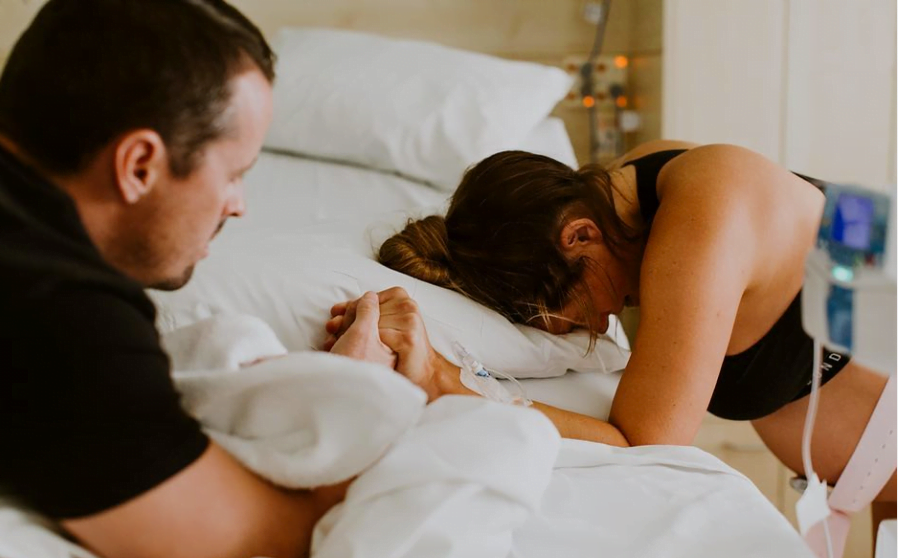I am in labor
Your water has broken or you're having irregular contractions. The baby is on the way!
Dilation
Contractions often start irregularly and are short. They naturally become stronger when you relax, or they may subside and resume after a few hours or days. During this initial phase, called the latent phase, your cervix shortens and begins to dilate. While contractions are irregular, it's best to do things you would normally do on a relaxing weekend day. This conserves your energy for later.
The active labor phase begins when contractions intensify, occurring every 3 to 4 minutes and lasting about 60 seconds each. From this point, labor typically does not exceed 24 hours. On average, this phase lasts 10-12 hours for a first child and around 4 hours for a second. The cervix, which had thinned out, continues to dilate up to 10 centimeters: full dilation. Meanwhile, the baby descends deeper into your pelvis and rotates with its back towards the front.
To the hospital
When you want to give birth in the hospital, we will move there when you have strong contractions and are dilated between 4 and 7 centimeters. If we leave earlier, there's a chance the contractions may stop due to the adrenaline from the new situation. Your midwife will call to check if there's a spot available at the hospital, and she will explain where you can park, etc.
Oxytocin and adrenaline
The labor hormone oxytocin increases steadily during labor, giving women powerful contractions. The presence of adrenaline counteracts oxytocin. Ensure as much oxytocin and as little adrenaline as possible by:
- heat (turning up the heating and wearing warm socks!)
- soft sounds & dimmed light
- love: cuddling
- turn off the sound of the phones
- seeking a quiet environment with few people
The pushing stage
At the end of the dilation period, during the peak of a contraction, you feel like you need to have a bowel movement. You let this happen, and it naturally lasts longer each time. When you feel throughout the entire contraction that you need to push the baby out, you will go along with it. The pushing stage begins!
During the pushing phase, you still have contractions with pauses in between. These pauses often become longer. You and your baby can rest during these pauses. You push the baby through the pelvis and pelvic floor. This typically lasts about an hour for your first child and 20 minutes for a second child. The position you choose for pushing is determined at the moment itself, together with the midwife.
Als de baby geboren is leggen we deze altijd bij jou op je buik, daar blijft de baby het beste warm. We vragen altijd of je partner of jij de navelstreng door wil knippen. Als er gehecht moet worden doen we dit terwijl de baby bij jou ligt, en wellicht al aan de borst drinkt. Pas daarna kijken we de baby uitgebreid na en wegen we hem/haar. We adviseren iedere pasgeborene na de geboorte 6 druppels vitamine K te geven. Dit bevordert de bloedstolling. Na een week ga je zelf vitamine K geven aan de baby, lees hier meer over in aflevering 9 ‘ik ben net bevallen’.
Transfer of care
To the gynecologist
During childbirth, there may be reasons to involve a gynecologist. For example, if the baby has passed meconium (stool) in the amniotic fluid, if labor is not progressing, or if you request pain relief. You may find the most anxiety-inducing reason for transfer is due to your child's condition, though fortunately, this type of transfer occurs the least (<1%).
Initiative
When your midwife transfers care to the hospital, she will leave once you are settled. In the hospital, there won't be continuous support. Therefore, take initiative to stay active. Sitting on a birthing ball, standing beside the bed, or using a birthing stool are also suitable in a medical setting. At OLVG-West, you can even choose to give birth in a bath if you wish.
Pain during childbirth
Bijna alle vrouwen ervaren bevallingspijn als heftig. Hoe je hier fysiek en mentaal mee om kan gaan lees je in aflevering 7: ‘Ik bereid me voor op de bevalling’. Ook pijnstillingsopties worden daar besproken.
Hospital bag
If you go to the hospital, take the following items with you.
- papers/midwife folder
- ID card and insurance card
- clothing for yourself
- clothing for the baby (long-sleeve onesie, pants, sweater, hat)
- baby blanket
- car seat (Maxi-Cosi)
- photo camera
- phone charger
- clothing + toothbrush for partner
- coin for the wheelchair
- You don't need to bring the maternity package, diapers, muslin cloths, and towels.
and more..
For partners
- Help remind her that every contraction passes, especially when she finds it tough at the peak of one.
- Make sure to keep eating and drinking yourself.
- When you are fit yourself, you can coach and support better.
- Trust that you know your girlfriend or wife best, making you the best coach she could wish for!
Listening tips
- Hypnobirth CD Marie Mongan
- Playlist ‘hypnobirth’ op spotify
- Doula-app
- Playlist amstermam
To do:
Keep breathing. Every contraction will pass, really!











